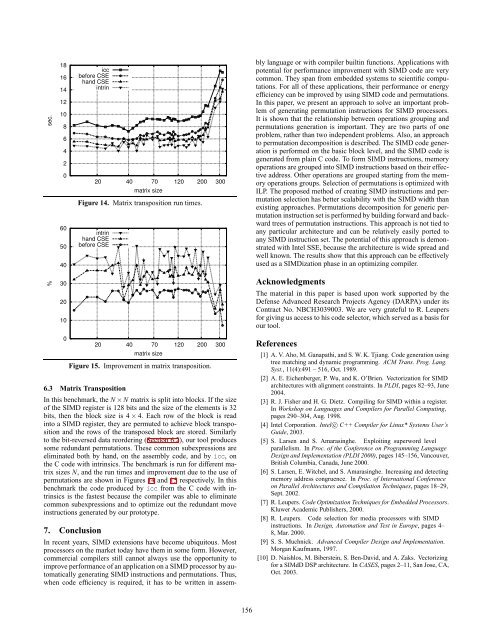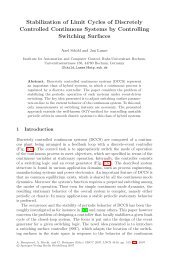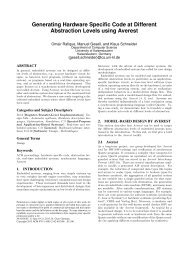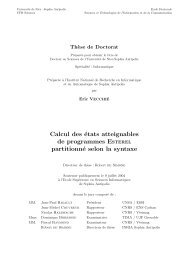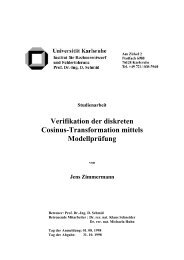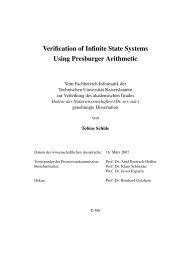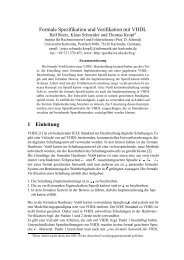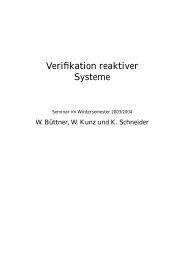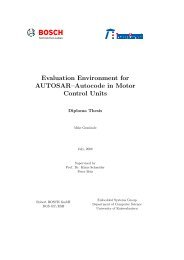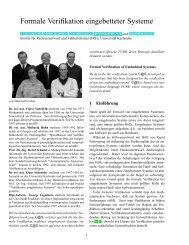Generation of permutations for {SIMD} processors - Embedded ...
Generation of permutations for {SIMD} processors - Embedded ...
Generation of permutations for {SIMD} processors - Embedded ...
You also want an ePaper? Increase the reach of your titles
YUMPU automatically turns print PDFs into web optimized ePapers that Google loves.
sec.<br />
18<br />
16<br />
14<br />
12<br />
10<br />
8<br />
6<br />
4<br />
2<br />
0<br />
60<br />
50<br />
40<br />
icc<br />
be<strong>for</strong>e CSE<br />
hand CSE<br />
intrin<br />
20 40 70 120 200 300<br />
matrix size<br />
Figure 14. Matrix transposition run times.<br />
intrin<br />
hand CSE<br />
be<strong>for</strong>e CSE<br />
bly language or with compiler builtin functions. Applications with<br />
potential <strong>for</strong> per<strong>for</strong>mance improvement with <strong>SIMD</strong> code are very<br />
common. They span from embedded systems to scientific computations.<br />
For all <strong>of</strong> these applications, their per<strong>for</strong>mance or energy<br />
efficiency can be improved by using <strong>SIMD</strong> code and <strong>permutations</strong>.<br />
In this paper, we present an approach to solve an important problem<br />
<strong>of</strong> generating permutation instructions <strong>for</strong> <strong>SIMD</strong> <strong>processors</strong>.<br />
It is shown that the relationship between operations grouping and<br />
<strong>permutations</strong> generation is important. They are two parts <strong>of</strong> one<br />
problem, rather than two independent problems. Also, an approach<br />
to permutation decomposition is described. The <strong>SIMD</strong> code generation<br />
is per<strong>for</strong>med on the basic block level, and the <strong>SIMD</strong> code is<br />
generated from plain C code. To <strong>for</strong>m <strong>SIMD</strong> instructions, memory<br />
operations are grouped into <strong>SIMD</strong> instructions based on their effective<br />
address. Other operations are grouped starting from the memory<br />
operations groups. Selection <strong>of</strong> <strong>permutations</strong> is optimized with<br />
ILP. The proposed method <strong>of</strong> creating <strong>SIMD</strong> instructions and permutation<br />
selection has better scalability with the <strong>SIMD</strong> width than<br />
existing approaches. Permutations decomposition <strong>for</strong> generic permutation<br />
instruction set is per<strong>for</strong>med by building <strong>for</strong>ward and backward<br />
trees <strong>of</strong> permutation instructions. This approach is not tied to<br />
any particular architecture and can be relatively easily ported to<br />
any <strong>SIMD</strong> instruction set. The potential <strong>of</strong> this approach is demonstrated<br />
with Intel SSE, because the architecture is wide spread and<br />
well known. The results show that this approach can be effectively<br />
used as a <strong>SIMD</strong>ization phase in an optimizing compiler.<br />
%<br />
30<br />
20<br />
10<br />
Acknowledgments<br />
The material in this paper is based upon work supported by the<br />
Defense Advanced Research Projects Agency (DARPA) under its<br />
Contract No. NBCH3039003. We are very grateful to R. Leupers<br />
<strong>for</strong> giving us access to his code selector, which served as a basis <strong>for</strong><br />
our tool.<br />
0<br />
20 40 70 120 200 300<br />
matrix size<br />
Figure 15. Improvement in matrix transposition.<br />
6.3 Matrix Transposition<br />
In this benchmark, the N × N matrix is split into blocks. If the size<br />
<strong>of</strong> the <strong>SIMD</strong> register is 128 bits and the size <strong>of</strong> the elements is 32<br />
bits, then the block size is 4 × 4. Each row <strong>of</strong> the block is read<br />
into a <strong>SIMD</strong> register, they are permuted to achieve block transposition<br />
and the rows <strong>of</strong> the transposed block are stored. Similarly<br />
to the bit-reversed data reordering (Section 6.2), our tool produces<br />
some redundant <strong>permutations</strong>. These common subexpressions are<br />
eliminated both by hand, on the assembly code, and by icc, on<br />
the C code with intrinsics. The benchmark is run <strong>for</strong> different matrix<br />
sizes N, and the run times and improvement due to the use <strong>of</strong><br />
<strong>permutations</strong> are shown in Figures 14 and 15 respectively. In this<br />
benchmark the code produced by icc from the C code with intrinsics<br />
is the fastest because the compiler was able to eliminate<br />
common subexpressions and to optimize out the redundant move<br />
instructions generated by our prototype.<br />
7. Conclusion<br />
In recent years, <strong>SIMD</strong> extensions have become ubiquitous. Most<br />
<strong>processors</strong> on the market today have them in some <strong>for</strong>m. However,<br />
commercial compilers still cannot always use the opportunity to<br />
improve per<strong>for</strong>mance <strong>of</strong> an application on a <strong>SIMD</strong> processor by automatically<br />
generating <strong>SIMD</strong> instructions and <strong>permutations</strong>. Thus,<br />
when code efficiency is required, it has to be written in assem-<br />
References<br />
[1] A. V. Aho, M. Ganapathi, and S. W. K. Tjiang. Code generation using<br />
tree matching and dynamic programming. ACM Trans. Prog. Lang.<br />
Syst., 11(4):491 – 516, Oct. 1989.<br />
[2] A. E. Eichenberger, P. Wu, and K. O’Brien. Vectorization <strong>for</strong> <strong>SIMD</strong><br />
architectures with alignment constraints. In PLDI, pages 82–93, June<br />
2004.<br />
[3] R. J. Fisher and H. G. Dietz. Compiling <strong>for</strong> <strong>SIMD</strong> within a register.<br />
In Workshop on Languages and Compilers <strong>for</strong> Parallel Computing,<br />
pages 290–304, Aug. 1998.<br />
[4] Intel Corporation. Intel c○ C++ Compiler <strong>for</strong> Linux* Systems User’s<br />
Guide, 2003.<br />
[5] S. Larsen and S. Amarasinghe. Exploiting superword level<br />
parallelism. In Proc. <strong>of</strong> the Conference on Programming Language<br />
Design and Implementation (PLDI 2000), pages 145–156, Vancouver,<br />
British Columbia, Canada, June 2000.<br />
[6] S. Larsen, E. Witchel, and S. Amarasinghe. Increasing and detecting<br />
memory address congruence. In Proc. <strong>of</strong> International Conference<br />
on Parallel Architectures and Compilation Techniques, pages 18–29,<br />
Sept. 2002.<br />
[7] R. Leupers. Code Optimization Techniques <strong>for</strong> <strong>Embedded</strong> Processors.<br />
Kluwer Academic Publishers, 2000.<br />
[8] R. Leupers. Code selection <strong>for</strong> media <strong>processors</strong> with <strong>SIMD</strong><br />
instructions. In Design, Automation and Test in Europe, pages 4–<br />
8, Mar. 2000.<br />
[9] S. S. Muchnick. Advanced Compiler Design and Implementation.<br />
Morgan Kaufmann, 1997.<br />
[10] D. Naishlos, M. Biberstein, S. Ben-David, and A. Zaks. Vectorizing<br />
<strong>for</strong> a SIMdD DSP architecture. In CASES, pages 2–11, San Jose, CA,<br />
Oct. 2003.<br />
LCTES’05, 10 2005/4/16<br />
156


